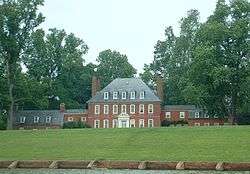Westover Plantation
|
Westover Plantation | |
|
Westover from the front (river) side | |
| Location | 7 mi. W of Charles City on VA 5, Charles City County, Virginia, United States of America |
|---|---|
| Coordinates | 37°18′40″N 77°8′58″W / 37.31111°N 77.14944°WCoordinates: 37°18′40″N 77°8′58″W / 37.31111°N 77.14944°W |
| Area | 1,025 acres (4.15 km2) |
| Built | c. 1750 |
| Architect | unknown |
| Architectural style | Georgian |
| NRHP Reference # | 66000923 [1] |
| VLR # | 018-0027 |
| Significant dates | |
| Added to NRHP | October 15, 1966 |
| Designated NHL | October 9, 1960[2] |
| Designated VLR | September 9, 1969[3] |
Westover Plantation is located on the north bank of the James River in Charles City County, Virginia. It is located south of State Route 5, a scenic byway which runs between the independent cities of Richmond and Williamsburg. It is a US National Historic Landmark.
History
Sir John Pawlett, by deeds of lease and release, demised most of Westover Plantation in 1665 to Theodorick Bland of Westover for £170.[4] Bland lived on the property until his death in 1671 and was buried in the chancel of the original Westover Church which he helped build.[5] His eldest son, Theodorick, inherited the land and joined with his brother, Richard, in its ownership.[4] The brothers eventually conveyed 1,200 acres of the property to William Byrd I in 1688 for £300 and 10,000 pounds of tobacco and cask.[4][6]
It is notable for its 18th-century and later history, when the mansion, Westover Plantation, was built in the Georgian style. It was considered the seat of the William Byrd family in Virginia. William Byrd II, the founder of Richmond, was thought to have built the mansion c. 1730. This date was part of the 1960 designation of the house as a National Historic Landmark. However, recent dendrochronologic testing on boards and planks in the house showed that they dated to the 1750s. The house was thus probably built and first occupied by William Byrd III, not his father. The revised construction date has been recognized by the National Park Service.[6]
Like the other plantations along the James River, Westover was first devoted to the cultivation of tobacco, the major commodity of colonial Tidewater Virginia. The Byrd family depended on the labor of hundreds of enslaved Africans, as tobacco was a labor-intensive crop. The original grounds included slave quarters, and slaves served also as domestic servants and skilled artisans of many types. As tobacco cultivation exhausted the soil, in the 19th century planters shifted to mixed crops.

During the American Civil War, Westover was used as headquarters of the Union Fifth Corps and one of the wings burned during this time.[7] In the early 20th century the estate was acquired by United States diplomat Richard Teller Crane, II who restored the mansion and grounds. The site was damaged by Hurricane Isabel in 2003. Ten feet of riverbank, a 250-year-old road, and a 150-year-old poplar from the south lawn were lost to the river during the storm.[2]
Architecture
The house is noteworthy for its secret passages, symmetry and balance of proportions, magnificent gardens, and architectural details. The grounds and garden are open 9 a.m. to 6 p.m. daily, but the house is not open to the public.
See also
References
- ↑ National Park Service (2006-03-15). "National Register Information System". National Register of Historic Places. National Park Service.
- 1 2 "Westover". National Historic Landmark summary listing. National Park Service. Retrieved 2008-06-27.
- ↑ "Virginia Landmarks Register". Virginia Department of Historic Resources. Retrieved 5 June 2013.
- 1 2 3 Tyler, Lyon G. (January 1896). "Title of Westover". William and Mary College Quarterly Historical Magazine. 4 (3): 151–155. Retrieved December 11, 2010.
- ↑ Bland, Theodorick (1840). "Appendix". In Campbell, Charles. The Bland papers: Being a Selection from the Manuscripts of Colonel Theodorick Bland Jr. of Prince George County Virginia. I. Petersburg, Virginia: Edmund & Julian C. Ruffin. pp. 145–149.
- 1 2 "Westover", James River Plantations, National Park Service, accessed 9 December 2010
- ↑ :The Gentry", James River Plantations, National Park Service Travel Itineraries, accessed 9 December 2010
External links
| Wikimedia Commons has media related to Westover Plantation. |
- Official website
- "Westover", James River Plantations, National Park Service
- "Westover", Virginia's James River Plantations
- Listing in National Historic Landmarks website
- Student account of a visit to Westover, Journals, College of William and Mary
- Westover, State Route 633, Westover, Charles City, VA: 73 photos, 8 measured drawings, 15 color transparencies, 5 data pages, and 6 photo caption pages at Historic American Buildings Survey
- Westover, Office Building, State Route 633, Charles City, Charles City, VA: 3 photos and 1 photo caption page at Historic American Buildings Survey
- Westover, Kitchen Building, State Route 633, Charles City, Charles City, VA: 2 photos and 1 photo caption page at Historic American Buildings Survey
- Westover, Tool Shed, State Route 633, Charles City, Charles City, VA: 2 photos and 1 photo caption page at Historic American Buildings Survey


